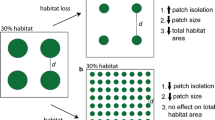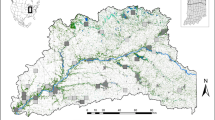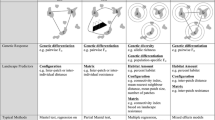Abstract
Little is known about how variation in landscape mosaics affects genetic differentiation. The goal of this paper is to quantify the relative importance of habitat area and configuration, as well as the contrast in resistance between habitat and non-habitat, on genetic differentiation. We hypothesized that habitat configuration would be more influential than habitat area in influencing genetic differentiation. Population size is positively related to habitat area, and therefore habitat area should affect genetic drift, but not gene flow. In contrast, differential rates and patterns of gene flow across a landscape should be related to habitat configuration. Using spatially explicit, individual-based simulation modeling, we found that habitat configuration had stronger relationships with genetic differentiation than did habitat area, but there was a high degree of confounding between the effects of habitat area and configuration. We evaluated the predictive ability of six widely used landscape metrics and found that patch cohesion and correlation length of habitat are among the strongest individual predictors of genetic differentiation. Correlation length, patch density and clumpy are the most parsimonious set of variables to predict the magnitude of genetic differentiation in complex landscapes.


Similar content being viewed by others
References
Andren H (1994) Effects of habitat fragmentation on birds and mammals in landscapes with different proportions of suitable habitat: a review. Oikos 71:355–366
Balkenhol N, Gugerli F, Cushman SA, Waits LP, Coulon A, Arntzen JW, Holderegger R, Wagner HH, Arens PFP, Campagne P, Dale VH, Nicieza AG, Smulders MJM, Tedesco E, Wang H, Wasserman T (2009) Identifying future research needs in landscape genetics: Where to from here? Landscape Ecol 24:455–463
Borcard D, Legendre P, Drapeau P (1992) Partialling out the spatial component of ecological variation. Ecology 73:1045–1055
Bowcock AM, Ruiz-Linares A, Tomfohrde J, Minch E, Kidd JR, Cavalli-Sforza LL (1994) High resolution of human evolutionary trees with polymorphic micorsatellites. Nature 368:455–457
Brown JH, Kodric-Brown A (1977) Turnover rates in insular biogeography: effect of immigration on extinction. Ecology 58:445–449
Bruggeman DJ, Wiegand T, Fernandez N (2010) The relative effects of habitat loss and fragmentation on population genetic structure. Mol Ecol 19:3679–3691
Burnham KP, Anderson DR (2002) Model selection and multimodel inference: a practical information-theoretic approach. Springer, New York
Cushman SA (2006) Effects of habitat loss and fragmentation on amphibians: a review and prospectus. Biol Conserv 128:231–240
Cushman SA, Landguth EL (2010) Spurious correlations and inference in landscape genetics. Mol Ecol 19:3592–3602
Cushman SA, McGarigal K (2002) Hierarchical, multi-scale decomposition of species–environment relationships. Landscape Ecol 17:637–646
Cushman SA, McGarigal K (2004) Hierarchical analysis of forest bird species–environment relationships in the Oregon coast range. Ecol Appl 14:1090–1105
Cushman SA, McGarigal K, Neel M (2008) Parsimony in landscape metrics: strength, universality, and consistency. Ecol Ind 8:691–703
Cushman SA, Compton BW, McGarigal K (2010) Habitat fragmentation effects depend on complex interactions between population size and dispersal ability: modeling influences of roads, agriculture and residential development across a range of life-history characteristics. In: Cushman SA, Huettman F (eds) Spatial complexity, informatics and wildlife conservation. Springer, Tokyo, pp 369–387
Epperson BK, McRae B, Scribner K, Cushman SA, Rosenberg MS, Fortin M-J, James PMA, Murphy M, Manel S, Legendre P, Dale MRT (2010) Utility of computer simulations in landscape genetics. Mol Ecol 19:3540–3564
ESRI (1999–2008) Environmental System Research Institute, Redlands
Ezard THG, Travis JMJ (2006) The impact of habitat loss and fragmentation on genetic drift and fixation time. Oikos 114:367–375
Fahrig L (1997) Relative effects of habitat loss and fragmentation on population extinction. J Wildl Manag 61:603–610
Fahrig L (1998) When does fragmentation of breeding habitat affect population survival? Ecol Model 105:273–292
Fahrig L (2001) How much habitat is enough? Biol Conserv 100:65–74
Fahrig L (2002) Effect of habitat fragmentation on the extinction threshold: a synthesis. Ecol Appl 12:346–353
Fahrig L (2003) Effects of habitat fragmentation on biodiversity. Annu Rev Ecol Syst 34:487–515
Fahrig L, Merriam G (1985) Habitat patch connectivity and population survival. Ecology 66:1762–1768
Fahrig L, Paloheimo J (1988) Effect of spatial arrangement of habitat patches on local population size. Ecology 69:468–475
Fahrig L, Pedlar JH, Pope SE, Taylor PD, Wegner JF (1995) Effect of road traffic on amphibian density. Biol Conserv 73:177–182
Flather CH, Bevers M (2002) Patchy reaction-diffusion and population abundance: the relative importance of habitat amount and arrangement. Am Nat 159:40–56
Gardner RH (1999) RULE: a program for the generation of random maps and the analysis of spatial patterns. In: Klopatek JM, Gardner RH (eds) Landscape ecological analysis: issues and applications. Springer, New York, pp 280–303
Gardner RH, Milne BT, Turner MG, O’Neill RV (1987) Neutral models for the analysis of broad-scale landscape pattern. Landscape Ecol 1:19–28
Gardner RH, O’Neill RV, Turner MG, Dale VH (1989) Quantifiying scale-dependent effects of animal movement with simple percolation models. Landscape Ecol 3:217–227
Gibbs JP (1998) Amphibian movements in response to forest edges, roads, and streambeds in southern New England. J Wildl Manag 62:584–589
Goslee SC, Urban DL (2007) The ecodist package for dissimilarity-based analysis of ecological data. J Stat Softw 22:1–19
Hanski I, Ovaskainen O (2000) The metapopulation capacity of a fragmented landscape. Nature 404:755–758
Harrison S (1991) Local extinction in a metapopulation context: an empirical evaluation. Biol J Linn Soc 42:73–88
Hill MF, Caswell H (1999) Habitat fragmentation and extinction thresholds on fractal landscapes. Ecol Lett 2:121–127
Keyghobadi N (2007) The genetic implications of habitat fragmentation for animals. Can J Zool 85:1049–1064
Landguth EL, Cushman SA (2010) CDPOP: an individual-based, cost-distance spatial population genetics model. Mol Ecol Resour 10:156–161
Landguth EL, Cushman SA, Luikart G, Murphy MA, Schwartz MK, McKelvey KS (2010) Quantifying the lag time to detect barriers in landscape genetics. Mol Ecol 19:4179–4191
Lindenmayer DB, Fischer J (2007) Tackling the habitat fragmentation pancheston. Trends Ecol Evol 22:111–166
Mantel N (1967) The detection of disease clustering and a generalized regression approach. Cancer Res 27:209–220
McGarigal K, Cushman SA (2002) Comparative evaluation of experimental approaches to the study of habitat fragmentation studies. Ecol Appl 12:335–345
McGarigal K, McComb WC (1995) Relationships between landscape structure and breeding birds in the Oregon coast range. Ecol Monogr 65:235–260
McGarigal K, Cushman SA, Neel MC, Ene E (2002) FRAGSTATS: spatial pattern analysis program for categorical maps. University of Massachusetts, Amherst
Neel MC, Cushman SA, McGarigal K (2004) Behavior and stability of landscape metrics across controlled gradients of landscape structure. Landscape Ecol 19:435–455
R Development Core Team (2009) R: a language and environment for statistical computing. R Foundation for Statistical Computing, Vienna
Reh W, Seitz A (1990) The influence of land use on the genetic structure of populations of the common frog Rana temporaria. Biol Conserv 54:239–249
Revilla E, Wiegand T (2008) Individual movement behavior, matrix heterogeneity, and the dynamics of spatially structured populations. Proc Natl Acad Sci USA 105:19120–19125
Schmiegelow FKA, Monkkonen MM (2002) Habitat loss and fragmentation in dynamic landscapes: avian perspectives from the boreal forest. Ecol Appl 12(2):375–389
Schumaker NH (1996) Using landscape indices to predict habitat connectivity. Ecology 77:1210–1225
Segelbacher G, Cushman SA, Epperson BK, Fortin M-J, Francois O, Hardy OJ, Holderegger R, Manel S (2010) Applications of landscape genetics in conservation biology: concepts and challenges. Conserv Genet 11:375–385
Semlitsch RD, Bodie JR (1998) Are small, isolated wetlands expendable? Conserv Biol 12:1129–1133
Short Bull RA, Cushman SA, Mace R, Chilton T, Kendall KC, Landguth EL, Schwartz MK, McKelvey KS, Allendorf FW, Luikart G (2011) Why replication is important in landscape genetics: American black bear in the Rocky Mountains. Mol Ecol 20:1092–1107
Smith AC, Koper N, Francis CM, Fahrig L (2009) Confronting collinearity: comparing methods for disentangling the effects of habitat loss and fragmentation. Landscape Ecol 24:1271–2185
Smouse PE, Long JC, Sokal RR (1986) Multiple regression and correlation extensions of the Mantel test of matrix correspondence. Syst Zool 35:627–632
Trzcinski MK, Fahrig F, Merriam G (1999) Independent effects of forest cover and fragmentation on the distribution of forest breeding birds. Ecol Appl 9:586–593
Villard M-A, Trzcinski MK, Merriam G (1999) Fragmentation effects on forest birds: relative influence of woodland cover and configuration on landscape occupancy. Conserv Biol 13:774–783
Wasserman TN, Cushman SA, Schwartz MK, Wallin DO (2010) Spatial scaling and multi-model inference in landscape genetics: Martes americana in northern Idaho. Landscape Ecol 25:1601–1612
Wiegand T, Moloney KA, Naves J, Knauer F (1999) Finding the missing link between landscape structure and population dynamics: a spatially explicit perspective. Am Nat 154:605–627
Wiegand T, Revilla E, Moloney ME (2005) Effects of habitat loss and fragmentation on population dynamics. Conserv Biol 19:108–121
With KA, Crist TO (1995) Critical thresholds in species’ responses to landscape structure. Ecology 76:2446–2459
With KA, King AW (1997) The use and misuse of landscape models in ecology. Oikos 79:219–229
With KA, King AW (1999) Extinction thresholds for species in fractal landscapes. Conserv Biol 13:314–326
Acknowledgments
We would like to acknowledge Rolf Holderegger for his exceptionally useful comments on an earlier version of this paper. Also, we thank two anonymous reviewers and the handling editor for their thorough and insightful suggestions on improving the manuscript.
Author information
Authors and Affiliations
Corresponding author
Rights and permissions
About this article
Cite this article
Cushman, S.A., Shirk, A. & Landguth, E.L. Separating the effects of habitat area, fragmentation and matrix resistance on genetic differentiation in complex landscapes. Landscape Ecol 27, 369–380 (2012). https://doi.org/10.1007/s10980-011-9693-0
Received:
Accepted:
Published:
Issue Date:
DOI: https://doi.org/10.1007/s10980-011-9693-0




